8 Omnichannel Customer Experience Examples Shaping 2025

Omnichannel customer experience examples now define business success in 2025. As digital expectations rise, companies see powerful results from unified engagement strategies. The global market for omnichannel solutions is projected to reach $9.48 billion in 2025, with an annual growth rate of over 11%.
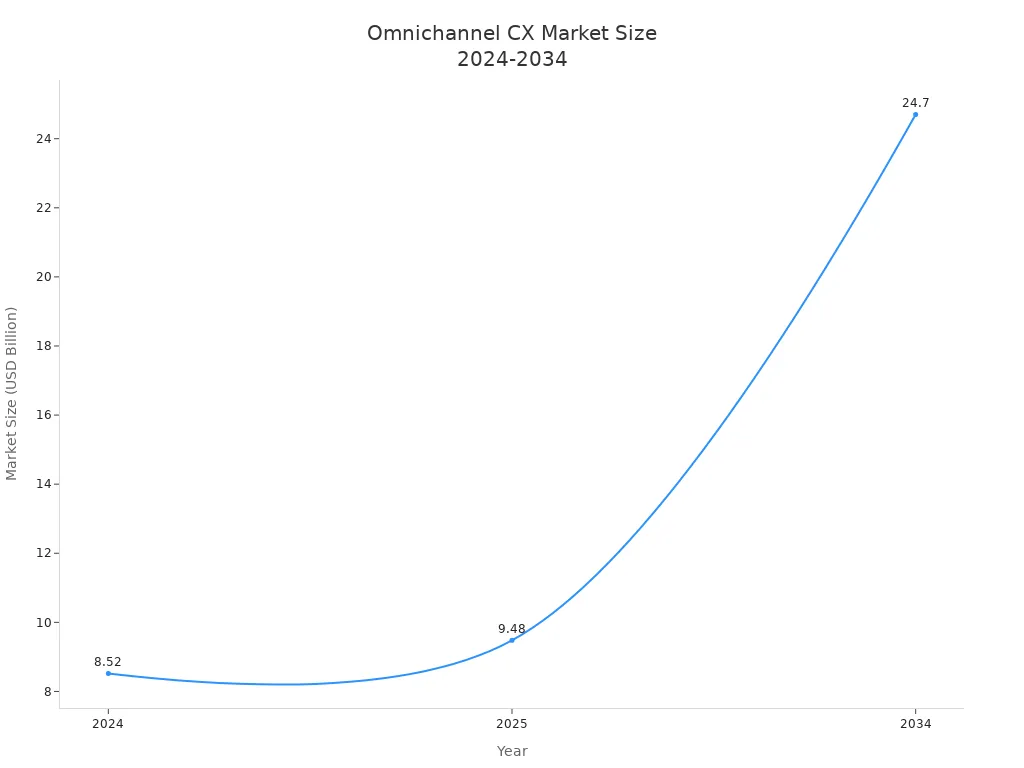
Organizations using digital customer experience platforms like Sobot AI report up to 91% improvement in customer retention. Omnichannel trends show that brands delivering seamless digital experiences meet evolving expectations and drive engagement. Each strategy in this field offers practical insights for elevating digital engagement and building lasting customer experience.
Personalized Journeys

AI in Personalization
Brands in 2025 rely on AI to create seamless, personalized shopping journeys across every digital touchpoint. AI-powered CRM systems analyze customer data, preferences, and real-time behavior to deliver hyper-personalization at scale. Companies like Sephora and Nike use AI to unify customer data, predict preferences, and offer personalized recommendations. For example, Sephora’s AI-driven virtual try-ons led to a 25% increase in online sales and a 15% boost in-store. BigBasket reactivated 20% of dormant users through AI-powered campaigns, showing the power of digital personalization.
Sobot’s Live Chat platform stands out by enabling businesses to deliver tailored customer interactions across all channels. The system uses AI to segment customers, analyze conversations, and provide agents with real-time insights. This approach ensures that every customer receives relevant, timely support, whether they connect via website, app, or social media. Sobot’s unified workspace keeps all interactions in one place, making it easy to maintain consistency and context.
Note: 81% of organizations are expected to use AI-powered CRM systems by 2025, driving a 53.1% annual growth in AI marketing investments. Source
| Aspect | Details |
|---|---|
| Key Technologies Used | Insider’s Architect, Netcore’s AI engine, Bloomreach’s agentic AI, SuperAGI’s omnichannel messaging |
| Benefits Achieved | Increased conversion rates, revenue growth, enhanced customer experience, improved loyalty |
| Engagement Uplift | BigBasket: 159% uplift in engagement via AI-driven email marketing |
| Sales Impact | Sephora: 25% increase in online sales, 15% in-store sales after AI integration |
| Customer Lifetime Value | 30% increase due to tailored omnichannel interactions |
Customer Benefits
Customers now expect personalized experiences at every stage of their digital customer journey. Omnichannel personalization allows them to switch channels without losing context, making interactions feel seamless and integrated. Studies show that 73% of consumers prefer brands offering consistent experiences across all platforms, and 80% are more likely to purchase from brands providing personalization.
Personalized shopping experiences build trust and loyalty. Customers receive tailored offers, relevant content, and real-time support, which increases satisfaction and engagement. Omnichannel strategies lead to higher retention rates—89% compared to 33% for single-channel approaches. Sobot’s AI-driven solutions help businesses meet these expectations by delivering hyper-personalization, ensuring every interaction feels unique and valuable.
Customers value the ability to choose their preferred channel and receive consistent, personalized support, which enhances convenience and drives repeat purchases.
Unified Messaging
Unified messaging stands at the core of modern omnichannel operations. Businesses in 2025 recognize that customers want to move between digital touchpoints without losing context. Unified messaging brings all conversations—whether from chat, email, SMS, or social media—into a single workspace. This approach creates seamless experiences and supports higher customer satisfaction. Companies that invest in unified messaging retain 89% of their customers, compared to only 33% for those with weaker strategies. Source
Seamless Channel Switching
Seamless channel switching allows customers to start a conversation on one platform and continue it on another without repeating themselves. Unified messaging systems solve the challenge of fragmented communication by consolidating all messages into one inbox. This setup keeps the conversation history intact and accessible, so agents always have the full context. Sobot’s omnichannel solution integrates digital channels like WhatsApp, Facebook, Instagram, and more, making it easy for teams to manage every interaction in one place. This integration reduces response times and ensures that customers receive consistent support across all digital touchpoints.
Note: Businesses often face technical challenges such as interoperability between platforms and ensuring data security. Sobot addresses these issues with robust APIs and strong encryption, helping companies deliver secure, unified customer experiences.
| Platform | Key Technologies and Features | Pricing Overview | User Ratings (G2 / Capterra) |
|---|---|---|---|
| Chatfuel | AI-powered chatbots, multi-channel integration, automation, analytics, live chat | $19.99–$300/month | 4.5 / N/A |
| HubSpot | Marketing automation, omni-channel CRM, unified help desk, advanced analytics | Free–$3,600+/month | 4.5 / 4.4 |
| Twilio | Multi-channel messaging, voice APIs, customizable contact center, user authentication | Pay-as-you-go | 4.2 / 4.4 |
| Tawk.to | Free live chat, ticketing, AI bots, unlimited agents | Free with paid options | 4.5 / 4.6 |
| Olark | Live chat, AI automation, chat routing, advanced reporting | $29/month per seat | 4.3 / 4.5 |
Agent Efficiency
Unified messaging boosts agent efficiency by reducing the need to switch between multiple platforms. Agents access a unified inbox with the entire customer conversation history, which helps them respond faster and with more accuracy. Automation features, such as AI-powered chatbots and auto-suggested replies, handle routine questions and free agents to focus on complex issues. Sobot’s omnichannel workspace gives agents real-time insights and intelligent routing, matching customers with the best-qualified team member. This setup leads to higher first contact resolution rates and greater agent satisfaction.
- Agents spend less time searching for information and more time solving problems.
- Intelligent routing and skills-based assignment improve productivity and customer loyalty.
- Businesses see financial benefits, including revenue growth and reduced costs, by streamlining digital customer experience management.
Unified messaging transforms omnichannel experiences, making every interaction smoother for both customers and agents.
Proactive Support
Predictive Analytics
Predictive analytics has become a cornerstone of proactive engagement in the omnichannel landscape. Companies use advanced algorithms to analyze customer data from every channel. This approach helps anticipate needs and deliver timely solutions. For example, businesses can spot early signs of dissatisfaction by tracking engagement and usage patterns. Support teams then reach out before problems escalate, reducing churn and building trust.
Many industries rely on predictive analytics for proactive engagement:
- Anticipating customer needs by analyzing purchase and browsing data to send reminders or offers.
- Personalizing interactions at scale using algorithms that assess preferences and behavior.
- Predicting and reducing churn by identifying early signs of dissatisfaction and enabling timely interventions.
- Enhancing operational efficiency by prioritizing high-impact tasks and optimizing resource allocation.
- Moving beyond reactive support to proactive, tailored service that improves loyalty and satisfaction.
Sobot’s omnichannel solution leverages predictive analytics to unify customer data from live chat, email, and social media. This unified view allows support teams to act quickly and deliver proactive engagement across all touchpoints. Real-time monitoring and automated alerts help agents resolve issues before customers even notice them.
Customer Satisfaction
Proactive engagement directly impacts customer satisfaction in omnichannel environments. When companies anticipate and resolve issues early, customers feel valued and supported. Research shows that 50% of customers switch brands after just one poor support experience (source). Proactive engagement helps prevent these negative outcomes.
Omnichannel platforms like Sobot enable agents to access complete customer histories. This access allows for faster, more personalized resolutions. Real-time analytics dashboards track satisfaction metrics such as CSAT and NPS, making it easy to spot trends and act quickly. Industries like retail, healthcare, and finance use proactive engagement to send alerts, reminders, and recommendations, improving loyalty and reducing churn.
Proactive engagement transforms the customer experience by turning support into a continuous, positive journey rather than a series of isolated events.
Self-Service Options
AI Chatbots
AI chatbots have become essential in omnichannel customer experience, providing instant support and efficient issue resolution. Businesses use these digital assistants to automate routine tasks, answer common questions, and guide users through complex processes. The integration of ai chatbots allows companies to deliver consistent service across all channels, improving both operational efficiency and customer satisfaction.
A recent study shows that 55% of customers have used chatbots, while 72% have accessed self-service portals. However, only 34% of consumers find ai chatbots helpful, and 35% believe they solve problems efficiently. This highlights the need for ongoing improvement and personalization in chatbot design.
| Customer Preference/Usage Metric | Percentage |
|---|---|
| Customers who have used chatbots | 55% |
| Customers who have used self-service portals | 72% |
| Customers using self-service portals to resolve issues | 70% |
| Consumers who find AI chatbots helpful | 34% |
| Consumers who believe chatbots solve problems efficiently | 35% |
Sobot’s AI-powered chatbot solution enables businesses to offer seamless, personalized support. The platform uses advanced ai and data analytics to understand customer intent, provide relevant answers, and escalate complex issues to human agents when necessary. This approach not only reduces operational costs but also enhances the overall digital experience.
24/7 Availability
Customers now expect support at any hour, regardless of location or time zone. The 24/7 availability of self-service options empowers users to resolve issues on their own schedule, increasing satisfaction and loyalty. Industry research indicates that 51% of customers expect round-the-clock assistance, with 34.7% considering it a baseline requirement.
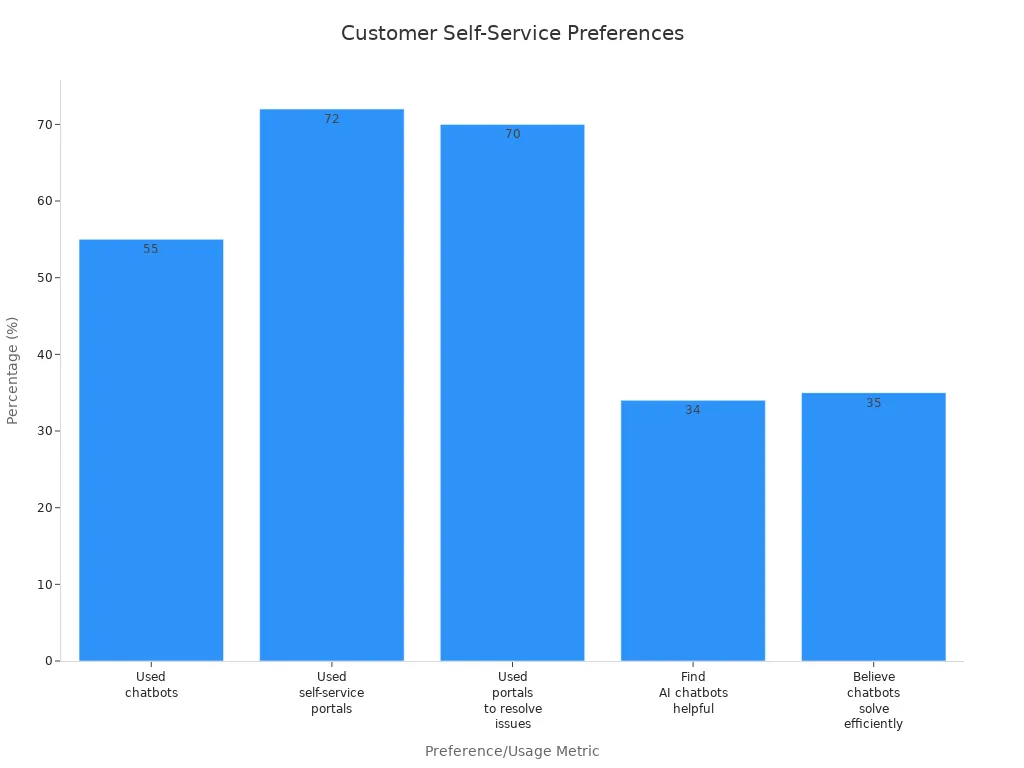
Self-service tools, such as ai chatbots and digital portals, allow businesses to scale support without increasing staff. Companies like Unity Technologies have saved millions annually by implementing these solutions. Sobot’s omnichannel platform ensures customers receive immediate, personalized help through automated systems, while agents focus on more complex requests. This model delivers faster resolutions, reduces costs, and supports a seamless digital journey.
Tip: Self-service options not only lower operational costs but also give customers control, making the experience more convenient and engaging.
Omnichannel Fulfillment
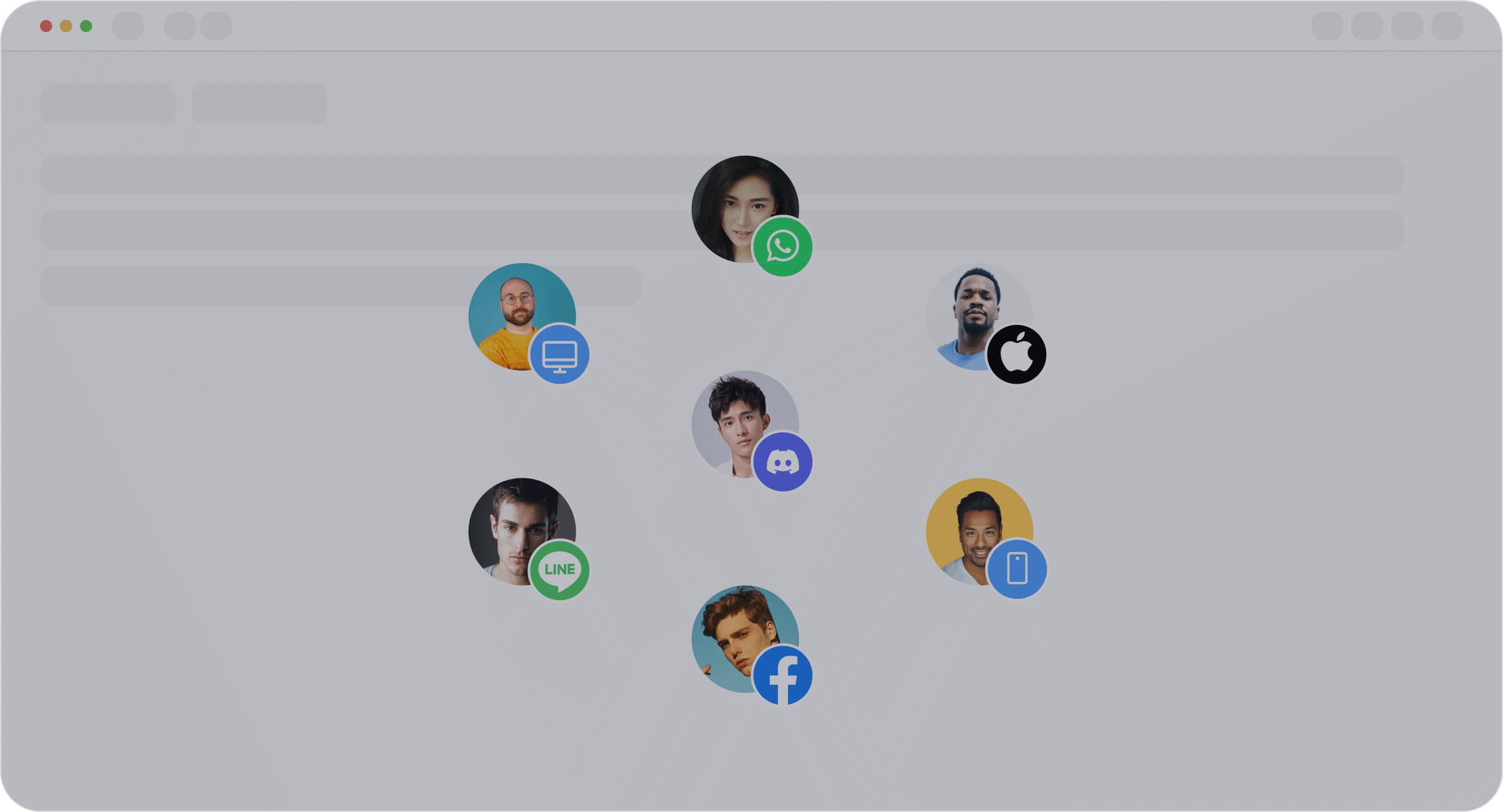
Omnichannel fulfillment strategies have transformed how retailers deliver value in 2025. Companies now blend online and offline experiences to meet rising customer expectations for speed and flexibility. Retailers use advanced order management systems, micro-fulfillment centers, and unified inventory tools to optimize costs and provide rapid delivery options. These innovations support seamless shopping experiences and drive customer loyalty.
Click-and-Collect
Click-and-collect, also known as BOPIS (Buy Online, Pick Up In Store), remains a top choice for shoppers who want convenience and control. Customers order online and pick up items at a nearby store, combining digital ease with physical access. This method bridges online and offline experiences, reducing shipping costs and encouraging more frequent purchases. Retailers like Walmart and Home Depot have seen increased foot traffic and incremental sales from click-and-collect services. According to the National Retail Federation, 90% of consumers expect a fast, convenient pickup experience.
Key benefits of click-and-collect:
- Reduces delivery costs for both retailers and customers.
- Improves inventory management with real-time tracking.
- Drives additional in-store purchases during pickups.
- Increases customer satisfaction and retention.
Sobot’s omnichannel solutions help retailers manage orders and inventory across all channels, ensuring accurate stock visibility and smooth order processing. This technology supports an enhanced shopping experience by keeping customers informed and engaged throughout the pickup process.
Curbside Pickup
Curbside pickup has become a staple for shoppers seeking speed and safety. Customers place orders online and receive items without leaving their vehicles. This approach merges online and offline experiences, offering flexibility and reducing wait times. Retailers like Target and Best Buy have optimized curbside pickup with dedicated staff and real-time notifications.
| Fulfillment Method | Customer Benefit | Retailer Benefit |
|---|---|---|
| Curbside Pickup | Fast, contactless pickup | Lower shipping costs |
| Click-and-Collect | Flexible pickup options | Increased store traffic |
Retailers face challenges such as inventory accuracy and system integration. However, investment in technology and staff training helps overcome these hurdles. Omnichannel fulfillment options like curbside pickup and click-and-collect boost customer loyalty and sales by delivering flexible, reliable service. These methods create an enhanced shopping experience that keeps customers coming back.
Tip: Diversifying fulfillment options allows retailers to adapt quickly to changing consumer preferences and market conditions.
Loyalty Programs
Consistency Across Channels
Successful omnichannel customer experience examples in 2025 show that loyalty programs must deliver seamless and consistent rewards across every touchpoint. Customers expect to earn and redeem points whether they shop online, use a mobile app, or visit a physical store. Brands now use unified customer profiles to track behavior and preferences, making every interaction feel personal and connected.
Key features of leading omnichannel loyalty programs include:
- Emotional connection and community building, which drive 65% more repeat purchases than traditional points-based systems.
- AI-powered personalization, blockchain for flexible rewards, and AR/VR for immersive experiences.
- Seamless cross-channel experiences, allowing customers to move between devices and platforms without losing progress.
- Dynamic reward structures, such as exclusive events and personalized recommendations.
- Integration of digital and offline channels, ensuring customers always feel recognized.
Sobot’s omnichannel customer experience solutions help brands unify customer data and deliver consistent loyalty rewards. Businesses using Sobot can personalize offers and communications, increasing engagement and satisfaction. This approach meets the rising demand for hyper-personalized, seamless loyalty experiences.
Note: Community-driven loyalty programs foster social bonds, resulting in 37% higher retention and 26% higher lifetime value.
Customer Retention
Omnichannel customer experience examples highlight the impact of loyalty programs on retention and lifetime value. Brands like Sephora and Netflix use AI and machine learning to personalize rewards, leading to low churn rates and millions of loyal customers. Personalized outreach at every stage of the journey strengthens relationships and reduces customer frustration.
Benefits of omnichannel loyalty programs for retention include:
- Consistent and rewarding experiences across all touchpoints.
- Tracking and rewarding activity in-store, online, and on social media.
- Tailored rewards based on unified customer data.
- Reduced churn and increased customer lifetime value.
Sobot’s platform enables brands to track customer activity and deliver targeted rewards, supporting long-term loyalty. Investing in quality loyalty programs not only reduces acquisition costs but also aligns teams around customer lifetime value goals. These omnichannel customer experience examples set the standard for customer retention in 2025.
Customers who receive personalized, seamless loyalty experiences are more likely to stay engaged and advocate for the brand.
Real-Time Engagement
Live Chat Solutions
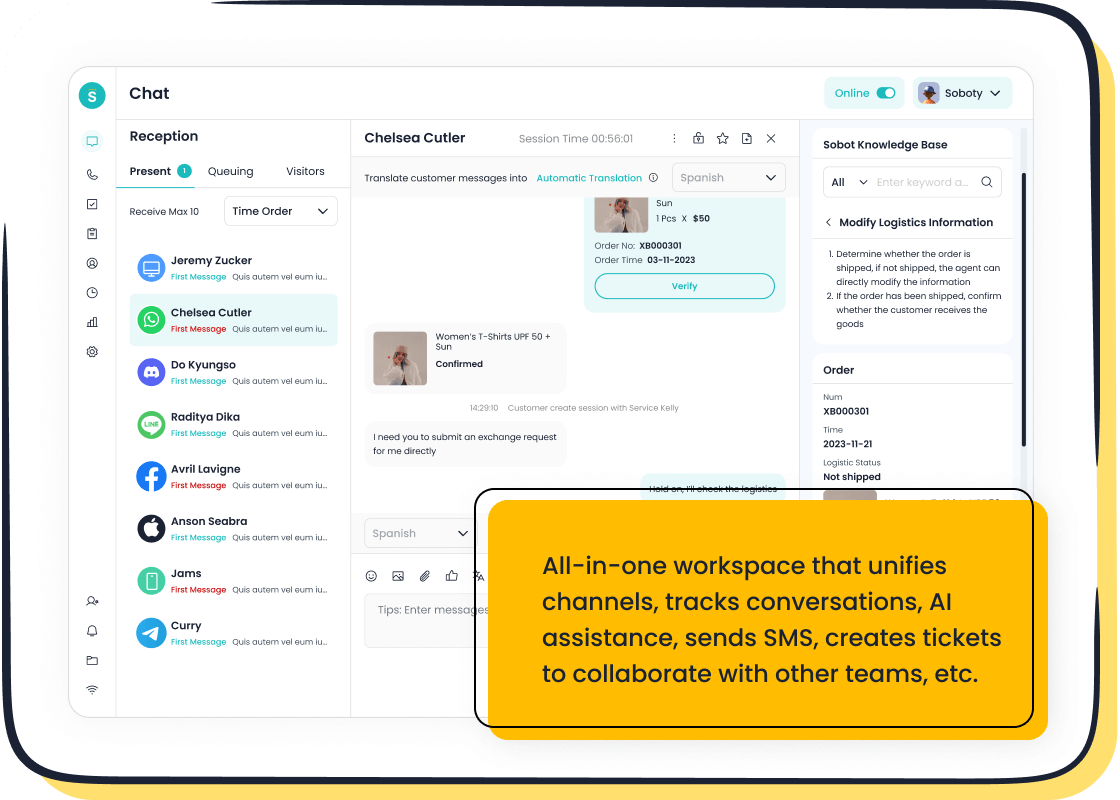
Real-time engagement tools have become essential for delivering outstanding customer experience in 2025. Businesses now use live chat to connect with customers instantly across digital channels. Sobot Live Chat enables companies to unify conversations from websites, apps, and social media into one workspace. This approach ensures that every interaction is fast, personal, and consistent, which is key for omnichannel strategies.
Customers expect immediate support. Research shows that 95% of people prioritize quality support, and 79% find live chat effective. Companies using live chat report a 20% increase in website conversions and a 305% return on investment from proactive chat strategies. Sobot Live Chat helps agents respond quickly, often within 36 seconds, and keeps all customer data in one place for seamless service. This level of engagement leads to higher satisfaction and loyalty.
| Metric / Statistic | Value | Explanation |
|---|---|---|
| Customers prioritizing quality support | 95% | Strong preference for effective real-time tools |
| Individuals perceiving live chat as effective | 79% | Broad acceptance among users and businesses |
| Customers expecting live chat widget on websites | 85% | High demand for real-time engagement tools |
| Increase in website conversions from live chat | 20% | Direct business impact supporting adoption |
| ROI from proactive live chat strategies | 305% | Strong business incentive to adopt live chat |
Tip: Fast, real-time engagement helps resolve issues on the first contact, reducing frustration and building trust.
Video and Chat Integration
Video and chat integration takes omnichannel customer experience to the next level. Many businesses now combine live chat with video support, allowing agents to guide customers visually. This method improves first-contact resolution rates and makes complex issues easier to solve. Real-time collaboration tools, such as shared customer profiles and instant messaging, help agents work together and deliver quick answers.
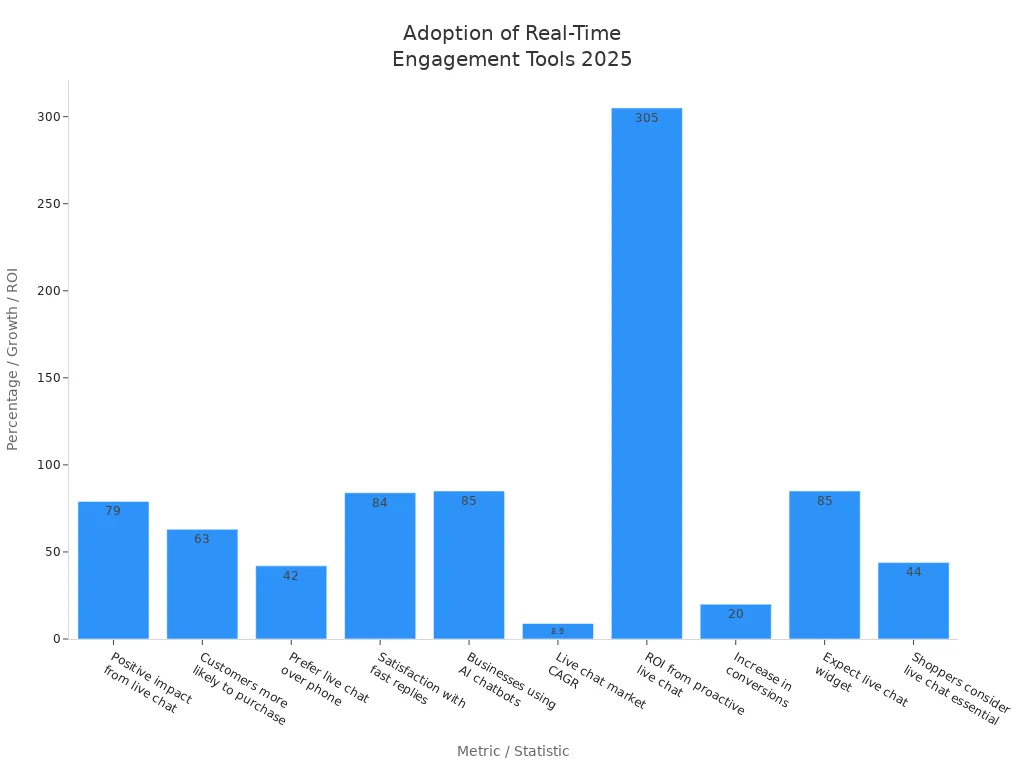
Sobot’s platform supports both live chat and video, giving agents the tools they need for effective engagement. When customers can switch between chat and video without losing context, they feel valued and understood. This seamless digital experience increases satisfaction and encourages repeat business.
- Real-time engagement tools improve first-contact resolution by enabling instant collaboration.
- Unified customer profiles ensure agents always have the right information.
- Integrated self-service and live support options make transitions smooth and efficient.
Personalization and real-time engagement now define successful omnichannel strategies. Companies that invest in these tools see higher customer satisfaction, better loyalty, and stronger business growth.
Social Commerce
Shoppable Experiences
Social commerce has redefined how brands connect with customers in 2025. Shoppable experiences now blend entertainment and instant purchasing, making the journey from discovery to checkout seamless. Brands use immersive technologies like augmented reality (AR) and virtual reality (VR) to let shoppers try products virtually. For example, virtual fitting rooms and AR-powered try-ons increase engagement and boost purchase rates.
A successful social commerce strategy often includes:
- Creating immersive AR/VR shopping experiences.
- Building a consistent content strategy, either as a brand influencer or by partnering with trusted creators.
- Balancing authenticity with platform-specific content to engage audiences.
- Hosting live shopping events to foster urgency and community.
- Adopting AI, AR, and live shopping tools for integrated omnichannel experiences.
| Strategy | Description | Example / Impact |
|---|---|---|
| Integrated Digital Storefronts | Product tagging and curated collections on Instagram and TikTok | CLUSE saw a 19% conversion rate increase |
| Live Shopping Events | Real-time product demos and customer interaction | Milk Bar maintained sales with Instagram live videos |
| Influencer Partnerships | Authentic endorsements to build trust | Fenty Beauty’s influencer campaigns drove strong growth |
| Emerging Technologies | AR/VR for virtual try-ons and personalized recommendations | Fashion retailers help customers visualize products |
Sobot’s omnichannel solutions support shoppable experiences by integrating social channels, enabling brands to manage campaigns and customer interactions in one workspace. This unified approach ensures customers enjoy a consistent journey, whether they shop on social media or a brand’s website.
Social Media Integration
Social media integration plays a vital role in omnichannel commerce. Brands now connect with customers across platforms like Instagram, Facebook, and TikTok, creating a seamless path from product discovery to purchase. This approach meets customers where they spend time and encourages engagement through interactive content, live streams, and shoppable posts.
- Brands track click-through rates, conversions, and revenue from social media-driven sales to measure effectiveness.
- Influencer marketing builds trust, with 70% of consumers influenced by recommendations from creators.
- User-generated content provides authenticity and turns customers into advocates.
- Mobile-first strategies are essential, as over half of online sales now happen on mobile devices.
Sobot’s platform enables brands to unify social media messaging, manage customer inquiries, and analyze engagement data. This integration supports timely, personalized responses and consistent experiences across all channels. Brands using Sobot can orchestrate customer journeys, deliver targeted offers, and improve loyalty through data-driven insights.
Tip: Brands that integrate social media into their omnichannel strategy see higher engagement, increased sales, and stronger customer loyalty. Learn more about social commerce trends.
The eight omnichannel customer experience examples highlight how businesses now meet rising expectations for seamless engagement and consistent service. Companies report higher loyalty, increased sales, and better data insights by adopting these strategy-driven approaches. To implement similar strategies, organizations should:
- Audit current touchpoints and map customer journeys.
- Invest in unified platforms, AI, and CRM integration.
- Continuously measure and optimize performance.
Sobot’s solutions help brands orchestrate these strategies, setting new standards for customer experience in 2025.
FAQ
What is an omnichannel customer experience example?
An omnichannel customer experience example shows how a brand connects with customers across many channels. For instance, a shopper can start a chat on a website, continue on WhatsApp, and finish in-store. Sobot enables seamless transitions, keeping all conversations unified and consistent.
How do omnichannel customer experience examples improve business results?
Omnichannel customer experience examples help companies boost retention and sales. Brands using these strategies see up to 91% higher customer retention rates (source). Sobot’s unified platform supports this growth by streamlining every customer interaction.
Why do customers prefer omnichannel customer experience examples?
Customers value omnichannel customer experience examples because they offer convenience and consistency. Studies show 73% of shoppers want seamless service across all platforms. Sobot’s solutions ensure customers never repeat themselves, which builds trust and loyalty.
How does Sobot support omnichannel customer experience examples?
Sobot provides an all-in-one contact center. Its Live Chat, AI chatbot, and omnichannel solution unify messages from websites, apps, and social media. This approach delivers fast, personalized support and helps businesses manage every customer journey efficiently.
What industries benefit most from omnichannel customer experience examples?
Retail, finance, gaming, and education see strong results from omnichannel customer experience examples. Sobot’s clients, such as Opay and Luckin Coffee, report higher satisfaction and lower costs after adopting these strategies. Every industry can improve engagement with the right omnichannel tools.
See Also
How To Successfully Deploy Omnichannel Contact Center Systems
Comprehensive Overview Of Omnichannel Call Center Platforms
Best Voice Of The Customer Tools To Use In 2024
